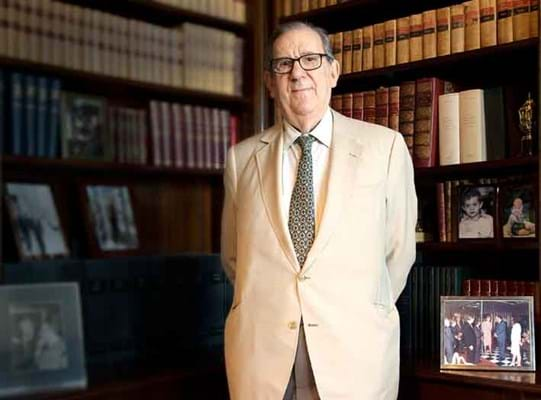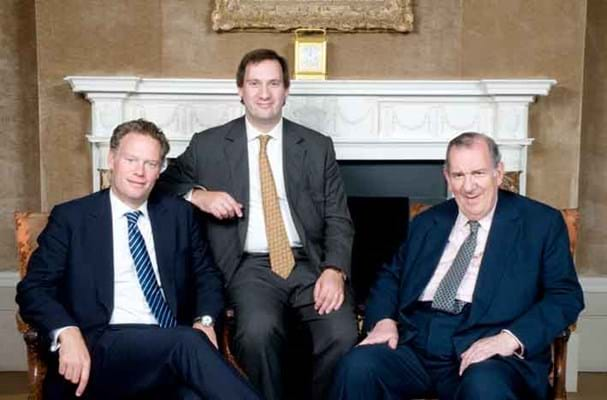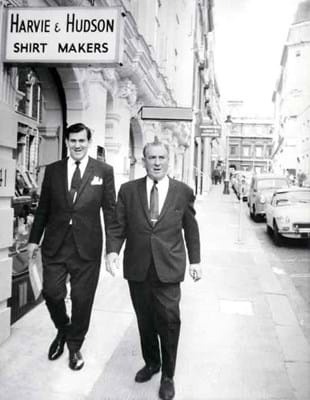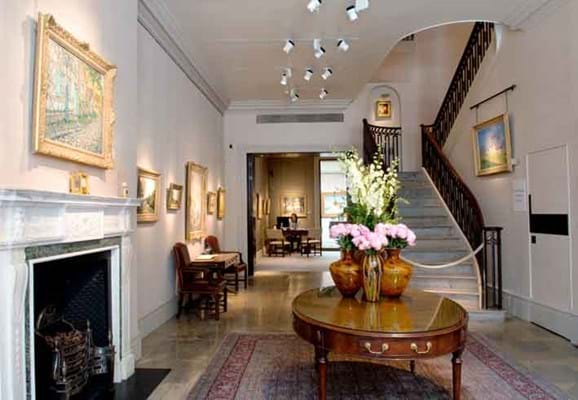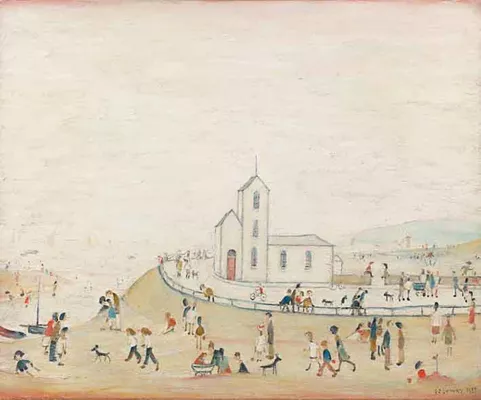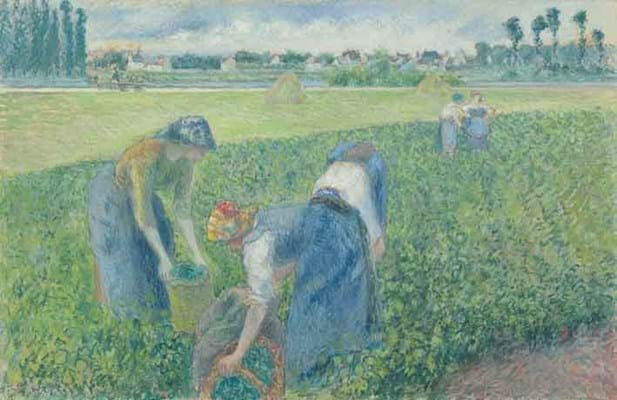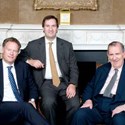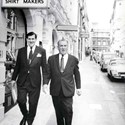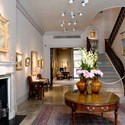Richard Green cannot imagine that anyone would want to read about him. About his gallery's paintings, yes. But certainly not about him.
While some dealers court publicity and a platform on which to talk about themselves, the head of the eponymous Mayfair art gallery is notoriously reticent about speaking to the press and guards his privacy fiercely.
Green sets out firmly to me that he wants this interview to be about the paintings and not about him, because it is the paintings that people are interested in rather than personal details.
A true art world enigma with 64 years in the trade behind him, here is a man who wields formidable power upon the London and international market yet is often unseen, preferring to eschew hectic social events and fairs.
We meet at one of the Green family's two Bond Street galleries, two of the handful of art galleries left on the street now dominated by monolithic fashion brands, and I don't mind admitting, for this interview, I'm a little nervous. He doesn't suffer fools.
Passing the Green Test
He also won't suffer second rate paintings. Possessed of astounding knowledge coupled with a hard head for business, Green is known for his rigorous research. Auction house specialists and fellow dealers speak of the critical intensity with which he views any work he is considering buying.
I ask him what criteria a work must meet to pass the Green test.
"First, it must be in the top 10% of an artist's oeuvre and from the best period," he replies. "Quality is all-important, and the subject must be right too. If the picture is good enough, we ask our restorer's opinion before we purchase it and we analyse the provenance carefully."
Keeping it in the Family
This meticulous method has served him and his family well over the decades. Green, who will turn 80 in April next year, is the doyen of the third generation business that was formed in 1936, the year he was born, when his father, James, opened a gallery on St James's Street in London.
Green grew up surrounded by art: "My parents always had interesting Victorian and 19th century European paintings at home. From the mid-1940s my father had a gallery at 130 Mount Street and I enjoyed looking at the Old Masters and other works there."
He left school at 15 to join the business: "From 1951 my father's gallery was at 9 New Bond Street. I learned all aspects of the business, viewed sales - there were far fewer in those days - and assisted with selling. My elder brother John and I would drive all over England to see clients and offer them paintings."
He learned to view works at his father's knee: "He taught me to look at a painting very carefully, to ask myself how it ranked in an artist's oeuvre, and also to look at condition."
Did his father's taste influence his own? "I'm certainly influenced by his delight in Old Masters and 18th and 19th century paintings. I remember him buying a wonderful Abraham Mignon flowerpiece from Anna Neagle's husband, the film director Herbert Wilcox. He also sparked my enthusiasm for Sir Alfred Munnings, as he dealt in many of his paintings, knew him well and used to take John and me to see him in Dedham. My father's Bond Street galleries had a sell-out exhibition of Munnings's works in 1956."
In 1955, not yet 20, Green started out on his own, working with his brother John from 1959 to 1964 before they went their separate ways. The following year, he and his wife, Jennifer, opened a gallery on Dover Street. When John Green rejoined the firm in 1993, he was in charge of all properties and oversaw the redevelopment of the award winning Modern art gallery at 33 New Bond Street designed by Adam Architects.
To this day it remains a tight-knit family business - sister, Penny Marks, has worked alongside Richard for many years, as have two sons - Jonathan, 53, and Matthew, 47. His daughter Marie-Claire also works at the firm.
Old Masters to Contemporary
The range of the gallery's stock, from Dutch Old Masters to Gerhard Richter, via the Impressionists, Munnings and Seago, is unusual. Accompanied by son Jonathan, we browse the paintings they will take to Masterpiece London later this month, at which they are exhibiting for the first time.
We start looking at Dutch and Flemish Old Masters and Impressionist works. We end, after a room of Lowrys, with a Bridget Riley abstract, about which Green enthuses with as much passion as the Jan Brueghel the Elder still life.
"I find it stimulating to deal in paintings from the 16th to the 21st centuries," he says. "I find things to interest me in almost all periods."
His own taste has changed over the years: "I've always dealt in paintings by Lowry, for example, as well as earlier works, but my interest in 20th century European art has been broadened by the enthusiasm of my sons Jonathan and Matthew. In 2011 we opened a purpose-built gallery at 33 New Bond Street specifically to display paintings and sculpture by artists such as Ben Nicholson, Patrick Heron, Henry Moore, Barbara Hepworth and Gerhard Richter."
His personal collection is equally broad ranging, a mix of 18th and 19th century British and French art, Modern British paintings and the occasional choice Old Master.
Certain paintings that have been through the gallery do stick in his mind: "There are a number of paintings that I've sold that I'd love to have hanging on my own walls at home today," he says. "Among them are Hendrick Avercamp's superb Winter scene, now in the Rose-Marie and Eijk van Otterloo Collection, and Hobbema's Wooded landscape, which we sold to the Getty.
"There's also a beautiful Monet from 1890, Champ d'avoine, which is now in the Harn Museum in Florida. However, the good thing about being a dealer is that there are always wonderful paintings coming on the market for us to discover."
Over the years his firm's increased financial clout has enabled Green to expand into the work of artists he could not afford when he started out, such as Picasso. However, he concludes: "I've definitely found great depths to appreciate in 20th century British art, but I still love the more traditional works."
Taking the Long View
Part of Green's success has been due to his ability to foresee and nurture markets for certain artists, such as John Atkinson Grimshaw whose work he has bought for decades. As with other big dealers, if the Greens are known to be buying the work of an artist at auction it has a powerful effect.
Having been in the business for so long, observing how fashions come and go, Green is not afraid to buy paintings that are currently 'unfashionable' if they are of quality. The gallery has the financial ability to do so, of course, and he trusts in the knowledge that one day their time will come again.
A case in point are the large marine paintings and a Sisley landscape hung in one of the gallery's rooms. Today the market for marines is undeniably hard work but Green is prepared to play the long game: "Even though the market for marine paintings is slow at the moment, when I find such fantastic quality in a pair of paintings by Charles Brooking [he gestures to a pair of paintings by the 18th century artist], I have to buy them.
"I owned The English privateer squadron 'Royal Family' engaging the French and Two Indiamen in the Channel 25 years ago, sold them to a good client and bought them back from his estate. I will find the right buyer again for them one day, but at this time I cannot tell you who, or when it will be."
Another 18th century painting, of Portsmouth harbour by John Cleveley the Elder, was bought at Sotheby's in December for the strong price of £290,500 (including premium) but, as his son Jonathan wryly points out, that's half a bid in a Contemporary art sale. Such are the vagaries of fashion.
The Sisley, on the other hand, was destined for Masterpiece, but has now been sold.
At Masterpiece London
The decision to exhibit at this year's Masterpiece reflects the changing nature of the art market and Green's trademark way of operating.
A few years ago, following the closure of the Grosvenor House fair, the gallery scaled back their London fairs to nil and, with typical consideration, sat back to watch how the capital's new fairs evolved.
Two years ago they joined the second edition of Frieze Masters, so why did Green decide to add Masterpiece this year? "We think it is a very high quality, stylish fair and we want to be there because we know our clients visit. Of course, we hope that we will meet other potential clients too."
Green agrees that, since the 1950s when he first entered the business, the explosion in art and antiques fairs worldwide has been one of the biggest changes: "By the 1970s there were essentially two major fairs - Grosvenor House Art and Antiques Fair and the Paris Biennale, plus we exhibited at the Hong Kong Fine Art Fair. But now there are probably at least 40 or 50 significant art fairs throughout the world."
"This business is now about galleries and fairs," adds Jonathan.
At TEFAF Maastricht this year, the Greens were one of a few British galleries to price every painting on their stand, even the multi-million works. A refreshing change and not one necessarily expected from a high profile gallery like this, with a reputation for dealing in the more expensive end of the market.
The reaction from the trade was, says Jonathan, largely negative as they were seen to be letting the club down by breaking rank. However, at Masterpiece again everything will be priced in an effort to make their business more transparent in this unregulated market.
The move - both at fairs and online - is in part to compete with auction houses. Like many so many dealers, Green feels the increasing power of the auctioneers is one of the main threats to commercial galleries, though years of experience, he says, help his firm to buy the best of what is on offer and sometimes to spot a sleeper.
Home Comforts
Outsiders speculate whether the gallery might expand internationally but Green is not tempted and believes a space in a different country will dilute the firm's activity rather. "London is exceptionally well situated to entice collectors both from east and west," he says. "London has a concentration of expertise, of objects, and it's a 'world city' which everybody visits sooner or later.
"Yes, we have occasionally thought about expanding internationally, but we don't really feel the need to. The internet is hugely effective and we exhibit at fairs in Maastricht, Paris, Monaco, New York and Palm Beach, as well as at Masterpiece and Frieze Masters in London."
The diversity of the firm's revenue suggests he has made the right call. The 2012/13 and 2013/14 accounts filed at Companies House for various Richard Green companies show that two-thirds or more of revenue has come from sources outside the UK for the past two years.
As for the future, though he is showing no signs of going anywhere yet, Green is grateful that his interest in art seems to be genetic: "Jonathan and Matthew were always very keen to join the business and have made a huge contribution to its success. We work very closely together and discuss every purchase and sale.
"I hope that my children and at least some of my nine grandchildren will continue to be involved with the gallery and develop the business successfully."
Big shoes to fill, but what an inheritance.
The Sport of Kings
Sporting paintings have always formed a large part of his gallery's stock, and Richard Green recalls visiting artist Sir Alfred Munnings in his youth. His interest neatly combines business and pleasure because horses are Green's other love - he owns a string of flat racers, many with art-themed names, including Art Collection, Dutch Art Dealer and Fine Art Dealer.
Green talks about them with the same passion, knowledge and seriousness as he does about art. "I'm proud of the success of horses that I have owned over the years," he reflects.
"In 1979 Charlotte's Choice won the Chester Cup. John Ferneley won the Lincoln in 2000. Art Connoisseur won the Coventry Stakes in 2008 and the Golden Jubilee Stakes in 2009, both at Royal Ascot. One of my current four-year-olds, Dutch Masterpiece, won the Flying Five Stakes at the Curragh in 2013 and looks set for a very good 2015 season."
As anyone who shares a love of horses and high-end fine art will understand, there's a certain similarity between the two - both involve their own arcane language and can be as exclusive to those who do not understand the obsession as they are unifying for those who do, both are exceptionally expensive and defy rationality, and you will always remember the best ones with real fondness.
Though, unlike a horse, the best art will, with luck, grow in value rather than end in ever larger vet's bills.


